Man has always been aware of himself as a part of nature, he is inextricably linked with it. These are single and indivisible concepts. The desire to be closer to the natural habitat is visible in everyone, which is manifested both in the established traditions and in the cultivation of indoor plants within the walls of your own home. We install flower pots, hang wreaths on the door, organize a vertical garden in the apartment, grow ornamental trees. It brings a feeling of calmness, serenity, harmony with oneself and the world around us.
Content
- Types of vertical gardening and their features
- On the ground
- Hydroponics
- Advantages and disadvantages
- Where to equip the garden
- In the living room
- In the bedroom
- In the kitchen
- Selection of plants and their characteristics
- Scindapsus
- Aglaonema
- Arrowroot
- Spathiphimum
- Dracaena
- Anthurium
- Guzmania
- Cissus
- Ivy varieties
- Philodendron
- Hypoestes
- Fern
- What to build from and how to create a vertical garden
- Three systems for creating a structure
- From polymer textile fabric
- Metal mesh with handkerchiefs
- Made of wood
- From pallets
- From plastic bottles
- From the pipes
- How to maintain a wall garden
- Conclusion
Types of vertical gardening and their features
Greening vertical surfaces is a simple and affordable option for decorating walls. Flowers allow you to realize any design ideas, create a unique interior. With the help of a wide variety of plants, differing in shape, leaf color, flexibility, photophilousness, growth rate, other parameters, you can create unique compositions, make each of them individual.
Fitostena is a vertical structure designed for landscaping the interior. Live, dry, artificial plants, as well as stabilized moss and flowers are used as greenery. All of these types can be combined with each other. The size of the eco-wall varies from 0.5 m² to 10 m² and more. If desired, it can be equipped with a built-in automatic irrigation system.
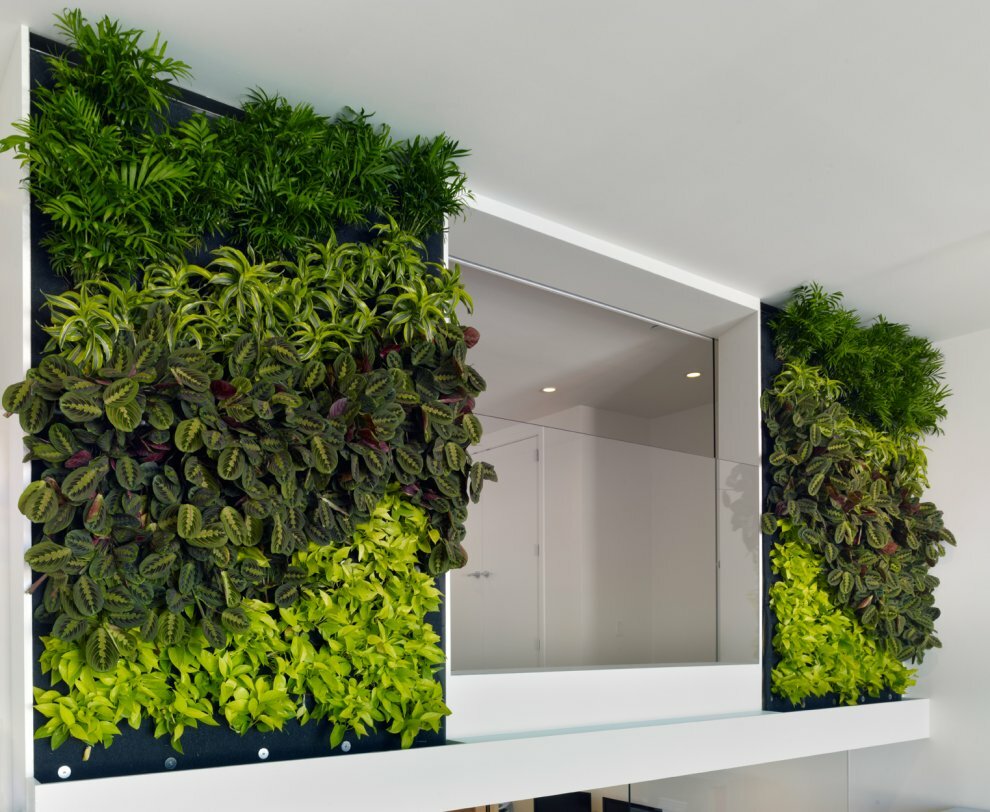

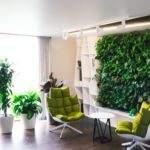
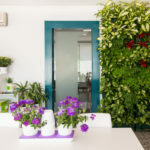
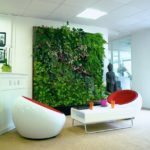

There is a wide variety of eco-constructions. They differ from each other in different ways:
- Form. Plantings can be given absolutely any shape, be it a square or a rectangle, an inscription on wall, they can also look like an arch or column, repeat steps, other unusual and complex images.
- Irrigation system: drip and flow. In the first case, water is supplied to each plant through tubes that are connected to a single tank. In the second version, the liquid is supplied to the top of the phytowall, from where it flows freely through the sections, irrigating each shelf.
- Method of planting placement: "pocket" or carpet, modular, shelf or container. The first option is a structure consisting of a strong frame to which fabric with pockets is attached. For the organization of the second model, special plastic phytomodules, manufactured industrially, are used. The third type is represented by homemade wooden, metal, glass shelves on which the pots are located.
- Module view. Fitokartina is an autonomous, closed suspension module of a small size with wide body walls. Phytomodule - allows you to make compositions of different sizes from fresh flowers. The main feature is the ability to combine several nodes to create an eco-wall that can be extended both in height and in width.
- Mobility. Stationary walls are mostly one-sided. Movable options are two-sided, often used as a partition to divide the space into functional zones.
On the ground
The cultivation method is another distinctive feature of phytowalls. There are two main technologies for growing live plants: on the ground, in hydroponics. Let us dwell on the first option in more detail. This method allows vertical gardening in the usual way, by planting crops in nutrient soil, which is filled in ceramic pots or plastic blocks.

Watering in such structures can be either automatic or manual. If the height of the eco-wall does not exceed 2 - 2.5 m, then there is no need to install automatic watering, it is enough to water the plantings with a watering can once every two weeks. In the absence of an automatic irrigation system, you can independently maintain phytowalls, clean them from dry leaves, dust, add fertilizers, etc.
The use of fertile soil masses in the organization of vertical gardening is typical for the countries of the post-Soviet space. This is primarily due to the cost of hydroponics-based technologies, as well as the mentality, because plants growing on the ground feel better, live much longer. In addition, we have a lot of land resources, and it costs significantly less than in Western Europe.
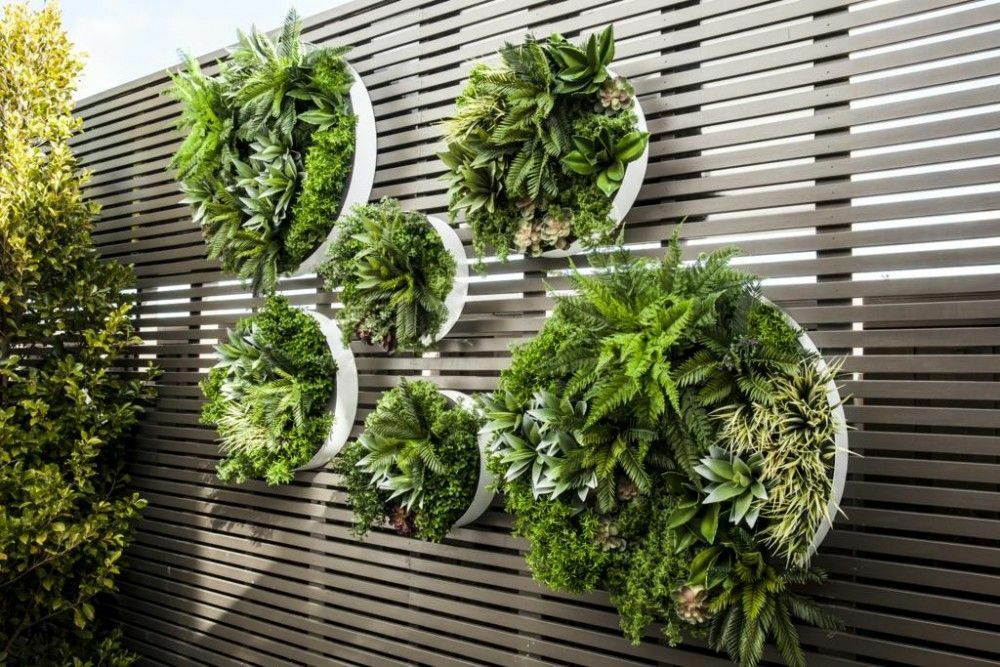
Maintenance of eco-walls on soil is much cheaper. Among the advantages, one can also highlight the fact that all structures are collapsible, they consist of block-pots filled with soil. They are quickly assembled and disassembled, and the transplantation of crops can be easily done by hand. However, it will not work to organize complex patterns, unique compositions, unthinkable patterns.
Hydroponics
Plants are grown without soil. Their root system is placed in felt or plastic containers fixed on a vertical base, and power is provided by automatic irrigation, the nutrient solution is supplied through tubes. Hydroponic phytowalls predominate in European countries, since indoor flowers are grown there on an industrial scale, and they are very cheap.
It is impossible to grow live plantations in artificial environments without automatic irrigation. The design is completely dependent on electricity. In the event of a prolonged power outage, pump breakdown, plants can die. Also, the system requires periodic maintenance, which cannot be performed independently, it is necessary to invite a specialist.
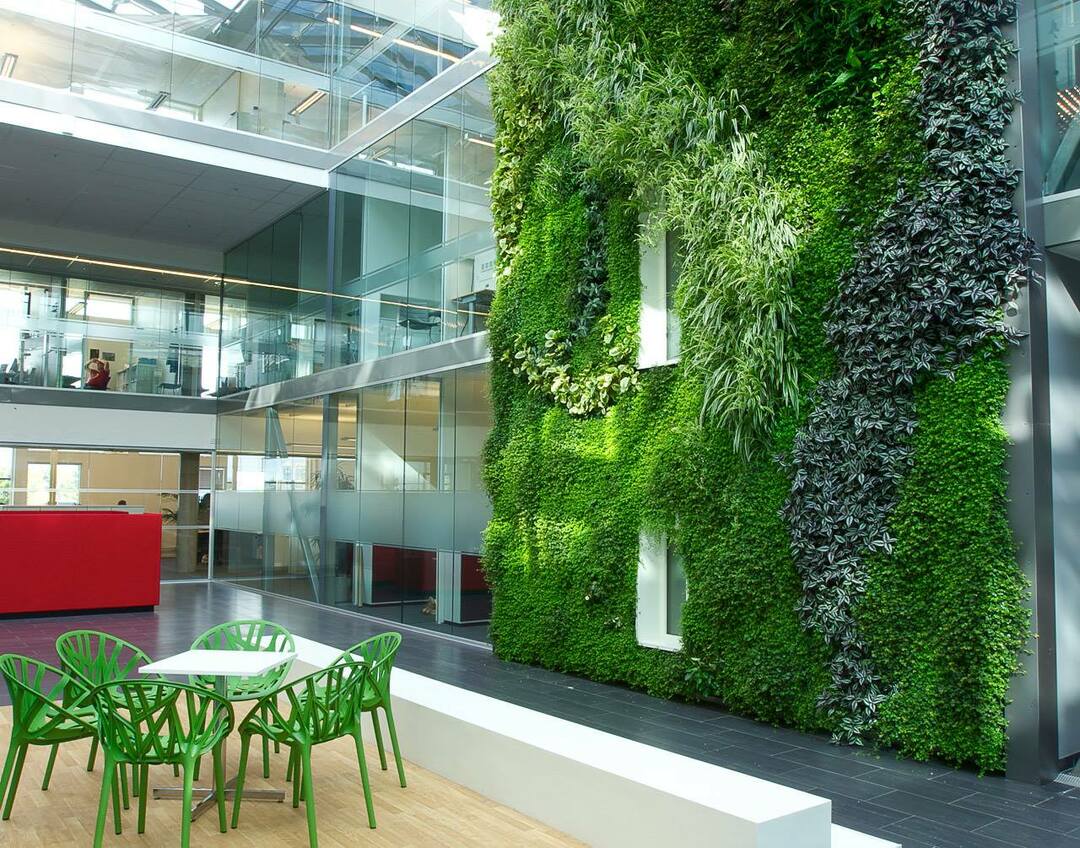
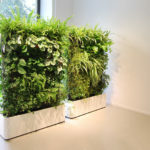
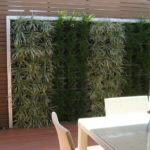
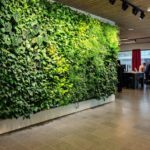
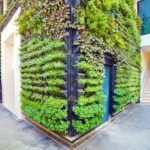
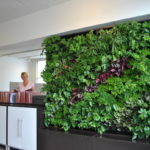
One of the main disadvantages of landscaping can be called the short life of the plantings, which varies within 3-6 months. Also, the structure has a rather complicated way of assembly and disassembly. Plants are planted directly on site, and only after the complete installation of the entire system. All of these factors affect the final cost and subsequent costs associated with crop replacement and maintenance.
Unlike eco-walls, organized on the ground, models on artificial environments allow you to place flowers in any position without observing geometry, and perform unique compositions. Also, the development of greenery, its growth occurs many times faster, since there is no need to develop a large root structure. However, it will not be possible to achieve the original smell inherent in plantings grown on the soil.
Advantages and disadvantages
Among the main advantages of eco-walls are its decorative properties. With its help, you can make an accent in the room, which will attract attention to yourself. Green compositions allow you to revive any, even the most unassuming room, it will look fresh, elegant, noble. Also, vertical gardening has a number of advantages, which are expressed in the following:
- Air cleaning. Plants absorb harmful substances in the room, which enter it through open windows, and are released from finishing materials and furniture. Phytowalls are a natural filter.
- Destruction of viruses and bacteria. Plantings cleanse the air from harmful microorganisms.
- Moisturizing. Plants concentrate and evaporate water, increasing the relative humidity, resulting in the most suitable microclimate in the house for life.
- Enriching the apartment with oxygen. If the air is saturated with oxygen, then a person breathes easier, also in such a space he rests better, sleeps better.
- Improving brain function. As a result of the research carried out, it was proved that in rooms where live plants are installed, people can concentrate better, and their efficiency increases.
- Decrease in temperature. Due to the absorption and evaporation of moisture, green spaces naturally lower the temperature, which is especially important during hot periods.
- Sound absorption. Greenery absorbs sounds and vibrations from the wall on which it is located.
- Zoning. With the help of eco-walls, you can divide a room into several functional zones, mobile structures are especially relevant for these purposes.
- Disguise flaws. Behind the phytowall, you can hide engineering communications, surface defects made during finishing.
- Saving space. There is no need to install flower pots and vases all over the house, occupying all the free corners.
- Environmental Safety. This is the cleanest type of decoration that is suitable for any room, including children's rooms.
- Stylish combination. The design is suitable for all directions, be it high-tech, loft, eco, country or others.
- Unlimited design possibilities. Unique compositions will make it possible to decorate any place in the house in an original way.
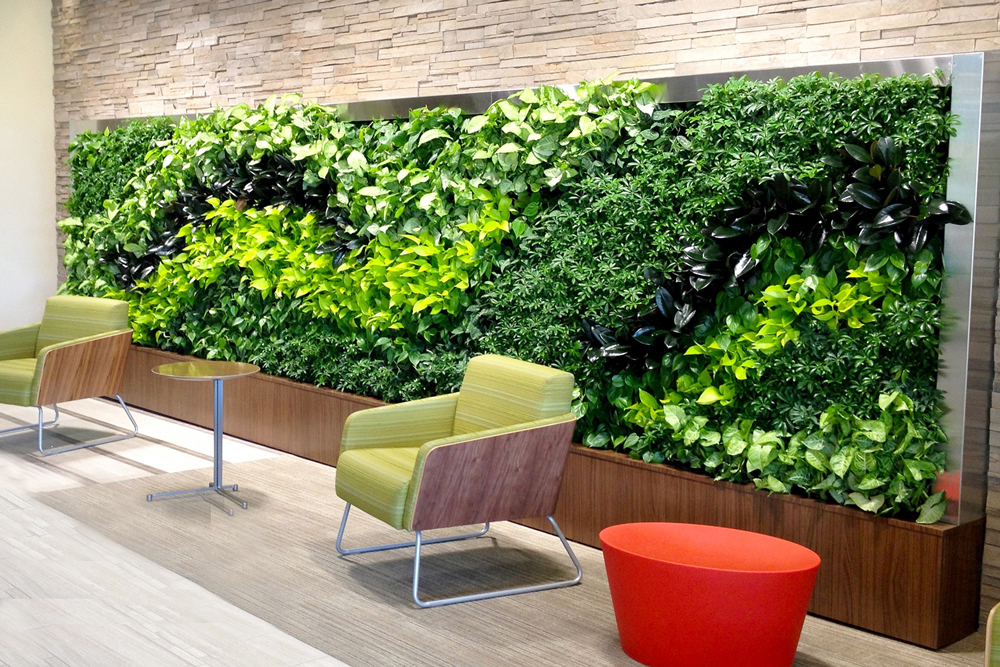
Vertical plantations are not devoid of disadvantages, among which are:
- Dampness. The phytowall is constantly in contact with water, and it also emits moisture itself, so the wall on which the object is placed will damp.
- Additional costs for electricity and maintenance. This only applies to options with an automatic irrigation system.
- Complex installation. Installation requires professional skills; doing the work yourself is problematic, and sometimes impossible.
Where to equip the garden
Vertical landscaping is a part of wildlife that can be placed in almost any room, even in the bathroom and toilet. It is not only able to become a decoration of the room, but it will also bring psychological pleasure, it will purify the air, saturate it with oxygen. This decor is lovely to look at. When observing, you can see how plants grow and develop, how they bear fruit, how the wilting process takes place.
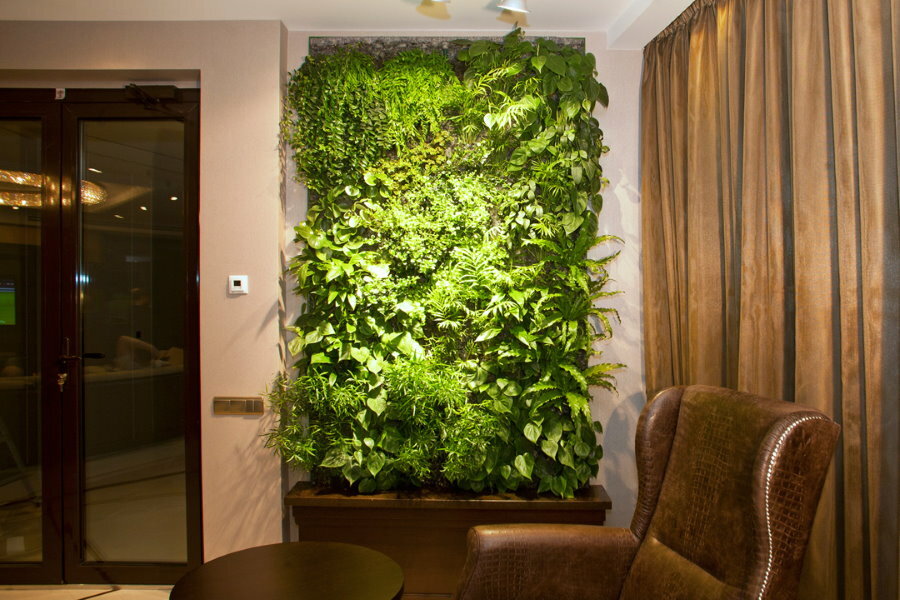
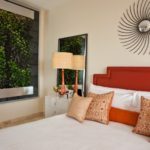
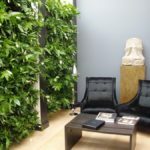
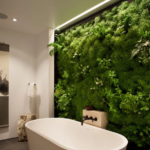

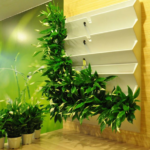
The choice of options for phytomodules, irrigation systems, the correct organization of lighting is carried out based on the characteristics of the room where the green wall will be installed. Firms engaged in the implementation of ready-made structures have entire catalogs in which, according to a photo or videos can be selected to match the existing room style, shape and size eco-walls.
In the living room
The hall is usually a fairly large room. This is the central room in the house that gets the most attention. It fully reflects the impeccable taste of the owners of the house, it should be the standard of quality, therefore, its design must be approached very responsibly. The living room cannot be overloaded with a huge amount of decor, which ultimately turns into trash.
The hall should be functional, spacious and comfortable. All these requirements are fully met by vertical gardening. It allows you to emphasize the individuality of the room, it can become a stylish accent in the overall interior. Here you can create mixed compositions from large and small plants, use climbing crops, organize whole panels from phyto-pictures.
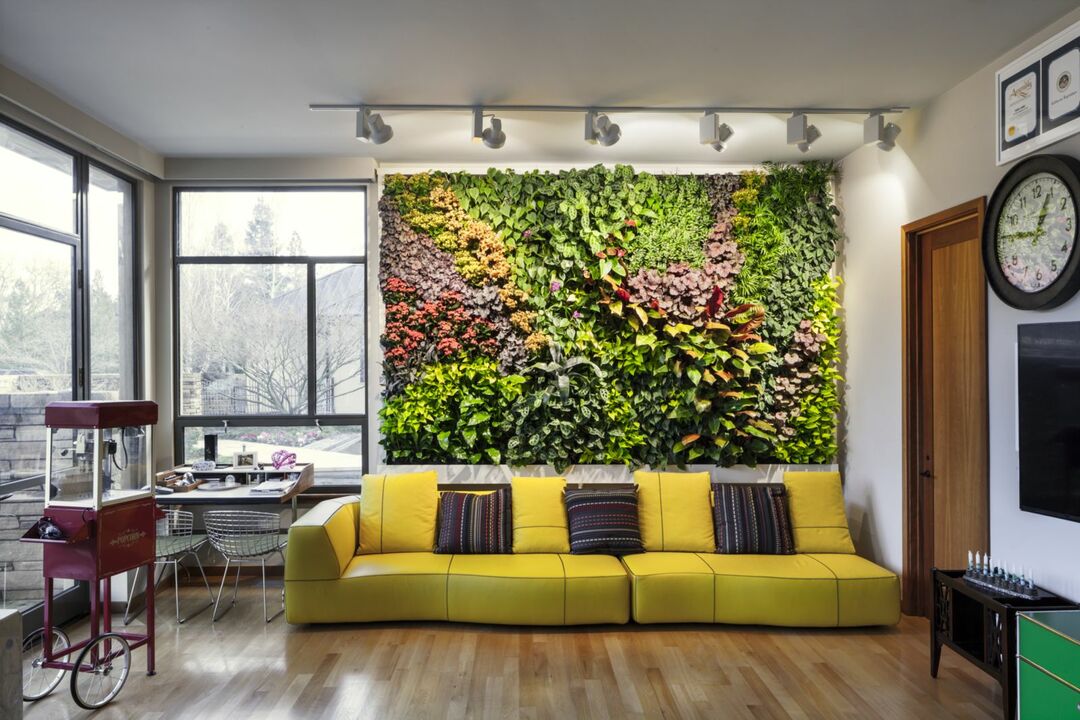
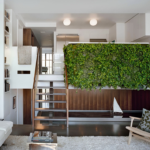
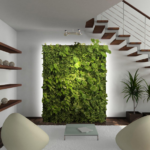
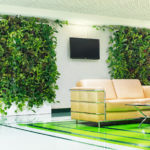
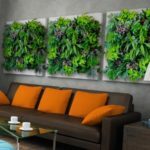
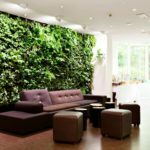
The choice of plants primarily depends on the location. If the phytowall is installed near the window and a lot of sunlight falls on it, then photophilous crops are chosen, regardless of the presence of additional artificial lighting. If the area is practically not illuminated by the sun, preference should be given to shade-loving options.
In the bedroom
The room is primarily intended for relaxation, so the atmosphere in it must be safe. A favorable climate is very important here, the quality of sleep depends on it. These factors must be considered when choosing suitable crops. First of all, you should abandon plants that have a pronounced odor, intoxicating aroma, from species that cause an allergic reaction and emit toxic substances.
It is also worth paying attention to the fact that living plantations intensively absorb oxygen at night, saturating the air with carbon dioxide. In order not to constantly feel oxygen starvation, dizziness in the morning, feeling unwell, you should not turn the room into a greenhouse. It is enough to place a small phytomodule here, or install one floor container shelf.

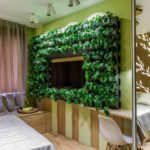
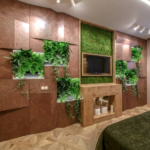
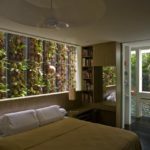
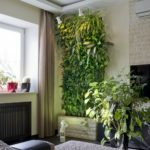
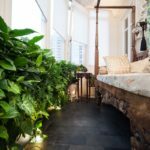
For the bedroom, you need to choose slow-growing plants, with small buds, or none at all. In this room, such types have proven themselves as: spathiphyllum, which cleans the air from harmful substances; fern with healing properties; aloe that absorbs formaldehyde; laurel, which soothes and promotes sleep; geranium, which secretes phytoncides useful for human health.
In the kitchen
The kitchen area is a favorite place for the whole family, food is prepared here, evenings are whirled around with long conversations. The room is almost always located on the sunny side, it is the warmest in the house. Moderate humidity is observed in it, constant ventilation is carried out, so different plants and flowers can be grown in the kitchen, which are used to organize vertical landscaping.
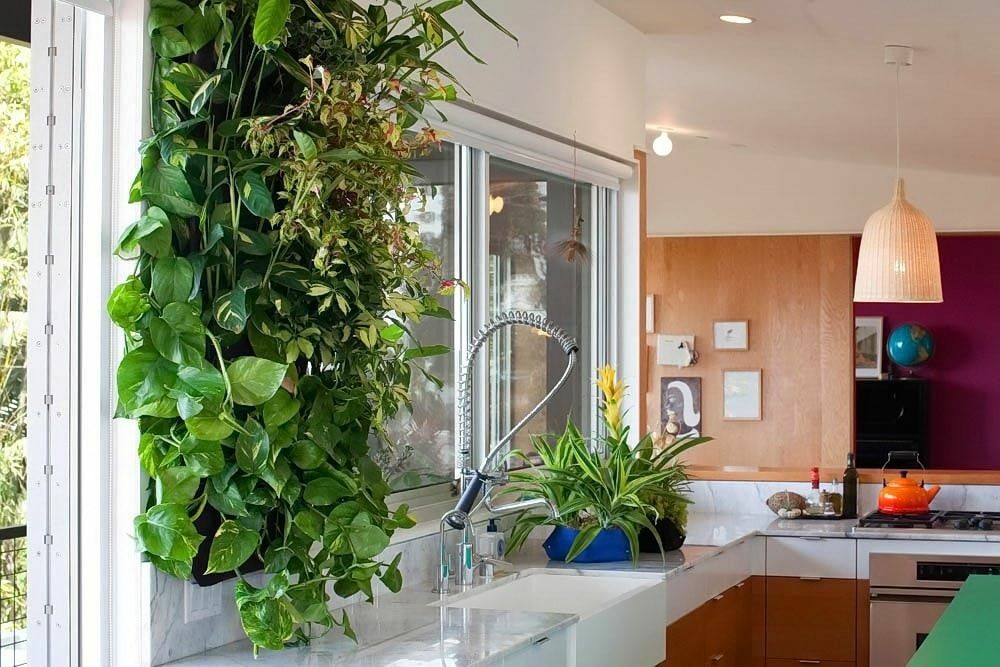

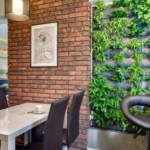
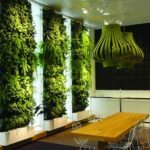
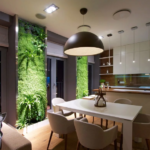
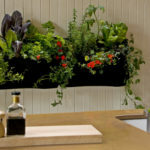
Due to the increased temperature, in comparison with the rest of the space in the house, thermophilic varieties should be selected for the room, for example, anthurium, begonia, coleus, and others. If the eco-wall is located near the window, a lot of sunlight will fall on it, then preference should be given to light-loving species such as pelargonium, dracaena, azalea, monstera, chitira.
It is strictly forbidden to install a phytowall near a refrigerator, oven, gas or electric stove.
Selection of plants and their characteristics
Any suitable plant can be used for vertical gardening. The choice of options is large enough. It can be both perennials and annuals, decorative deciduous or flowering specimens. Miniature shrubs and mosses, various herbs are suitable. Starting to work on the organization of space, first of all, it is necessary to determine their characteristics, to create a visualization of the future wall composition.
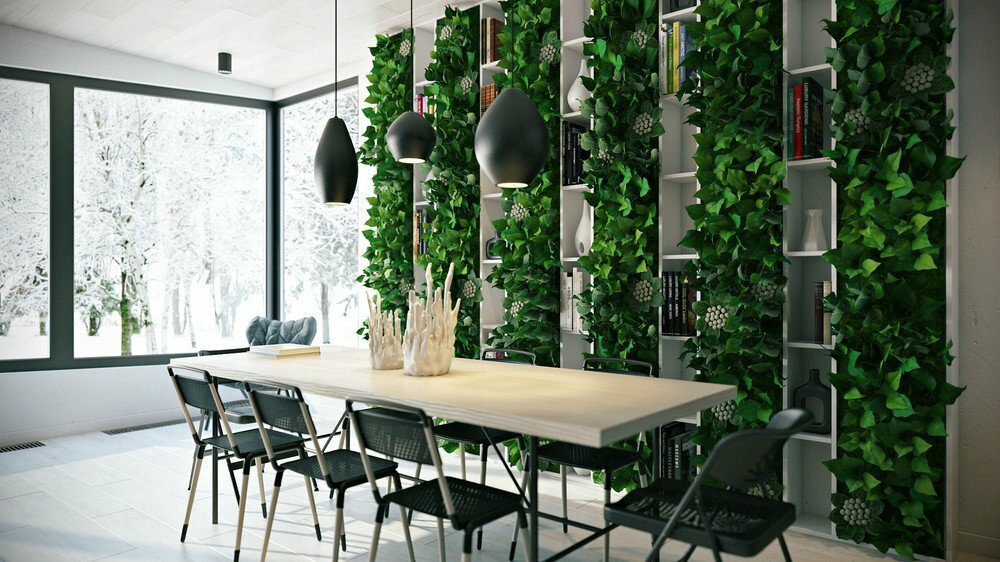

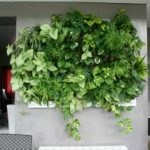
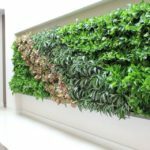
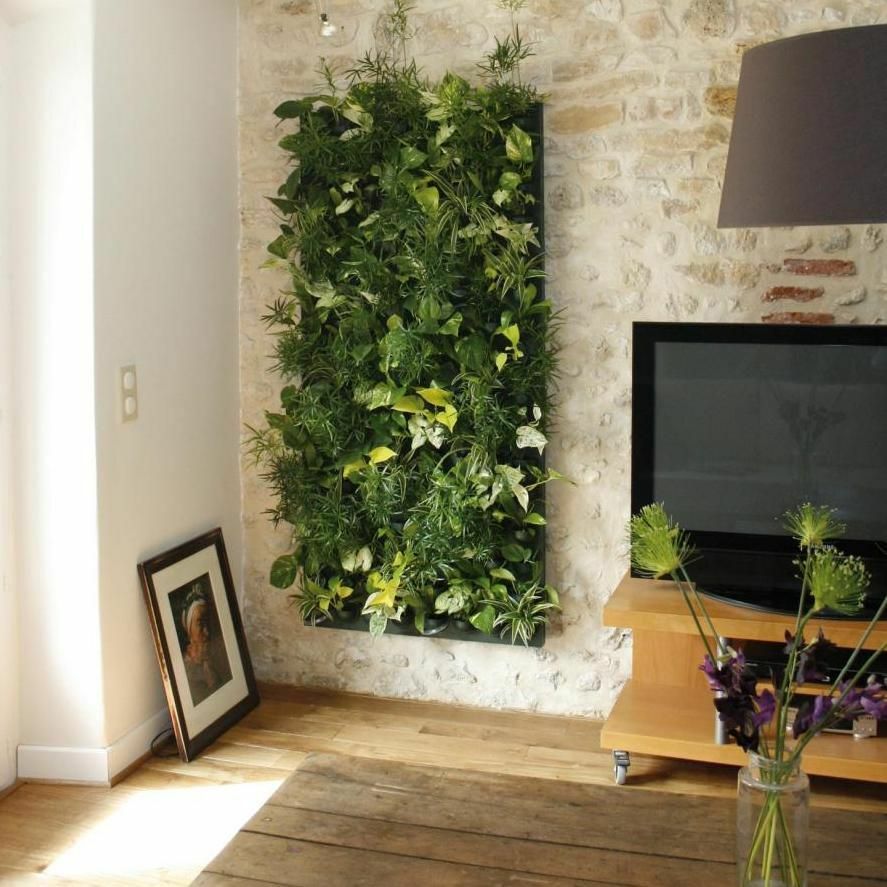

Scindapsus
A curly liana rises up on aerial roots. All 25 species take root well in apartment conditions, do not stand out for being whimsical. A suitable temperature is 18 ° C, in winter it is within 12 ° C. Scindapsus likes bright light, but in direct sunlight it slows down growth and turns yellow. To keep the leaves bright, greens should be sprayed daily with soft water. Fertilize the plant in moderation. The suitable period is from May to October, when the phase of active growth begins.
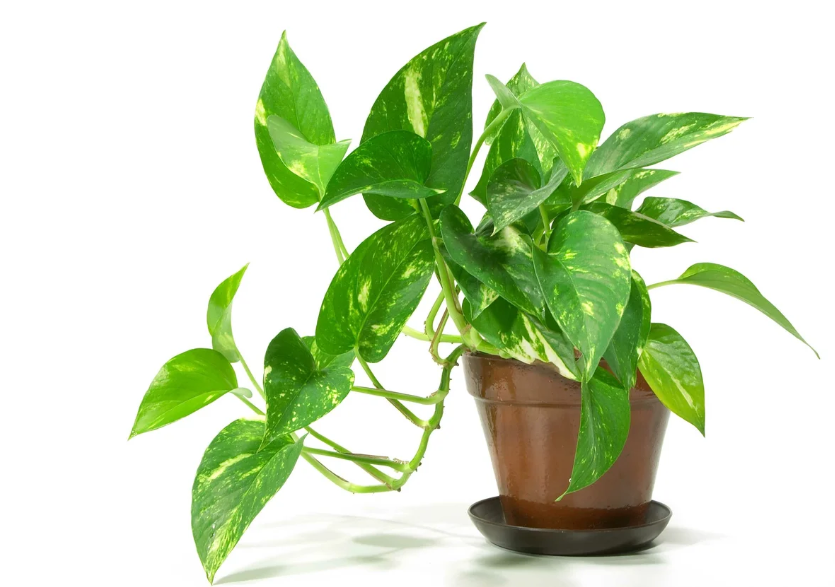

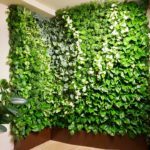
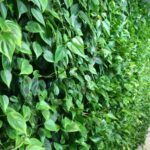
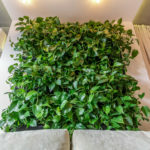
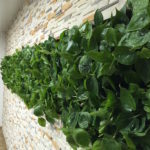
A beautiful scindapsus, in addition to its visual appeal, has a lot of useful properties. It creates a comfortable psychological environment, has a beneficial effect on the metabolism. If you place it on a plastic panel in the kitchen, you can feel a daily surge of energy, an additional pleasure from eating.
Aglaonema
An ornamental plant looks like a shrub. Large, oblong leaves are located on short, dense stems. The ideal temperature for thermophilic aglaonema is 20 ° C, in winter it can be lowered to + 15 ° C. Such flowers are undemanding to lighting, I can grow freely in partial shade or in bright sunlight. Massive leaves require frequent spraying, and the soil needs to be moistened. The recommended feeding frequency is twice a month, during the period of active growth.
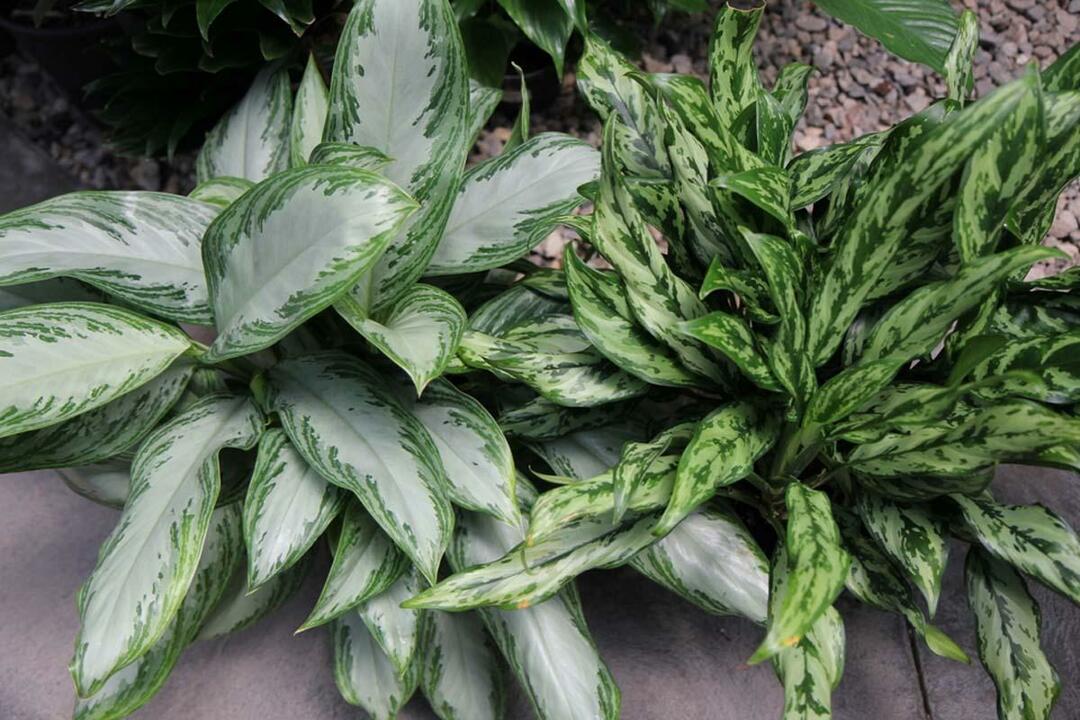
The evergreen perennial has about 22 species. The most suitable for vertical structures indoors are Maria, Red Diamond, Silver. Aglaonema is ideal for a vertical plant stand in a study or living room. It helps to improve performance, helps to fight stress. The plant purifies oxygen in the room, saturates it with air ions.
Arrowroot
Herbaceous perennial has an unusual color of the leaf plate. Oval leaves are decorated with streaks and red spots. Depending on the variety, this feature may change, acquiring a different shade. A heat-loving indoor flower feels comfortable at a temperature of 20-25 ° C. This indicator must be stable, otherwise the plant will quickly lose its attractive appearance. Also, you should not place the vertical composition in a draft.
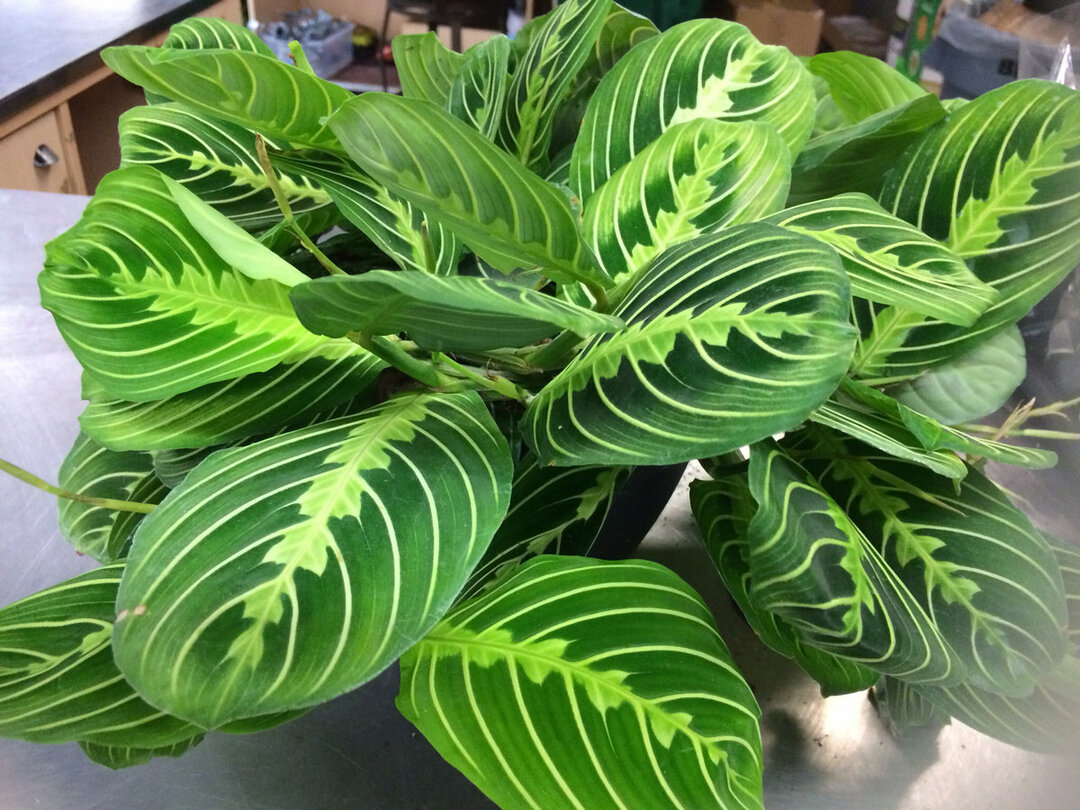
It is better to place a stand with arrowroot in the bedroom. The plant has unique energy, is able to improve internal well-being, and has a beneficial effect on sleep. With proper care, the flower will delight with its unique appearance all year round.
Spathiphimum
The tropical evergreen plant is also called female happiness. The main feature of the spathiphimum is the absence of stems. Large oval leaves and arrows with graceful flowers grow straight from the ground. The ideal growing temperature is 22 ° C, in winter - not lower than 15 ° C. Vertical flower beds are best placed in partial shade, away from direct sunlight.
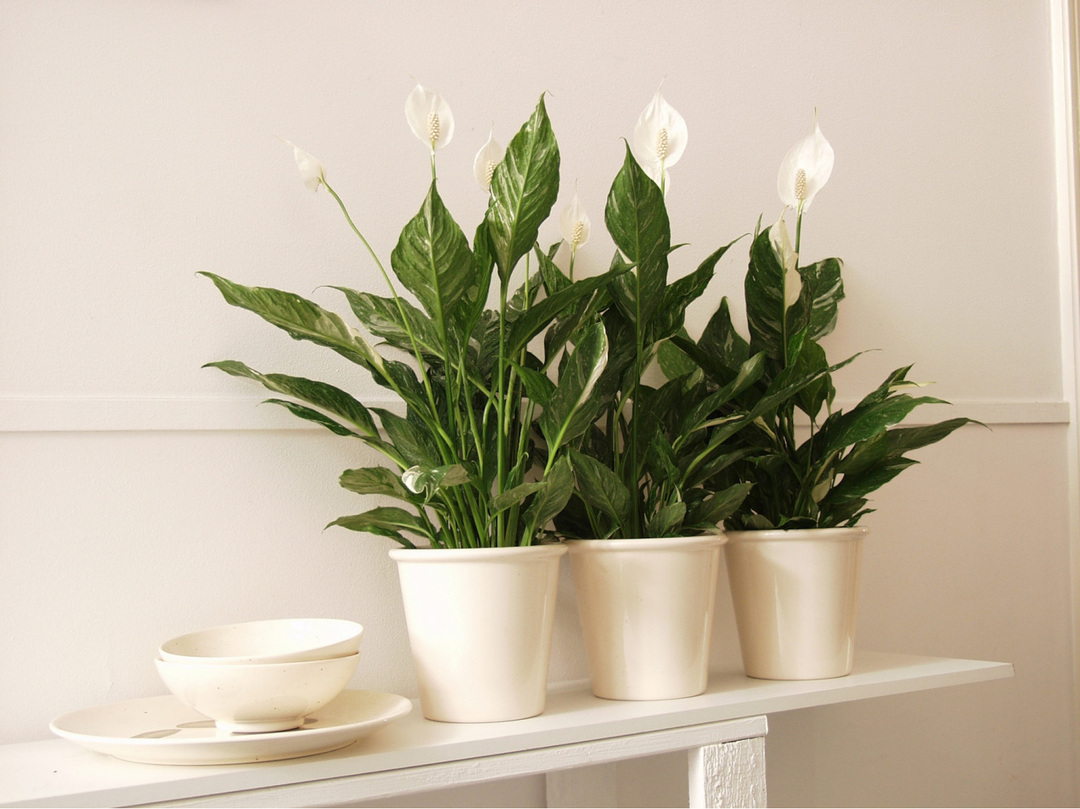
Florists do not recommend to abuse Spathiphymum when collecting the composition, since their foliage contains a poisonous substance - calcium oxalate. In large quantities, it can irritate the mucous membranes. Of the useful properties, one can note the ability to cleanse the air from harmful substances, toxic elements.
Dracaena
Such an ornamental deciduous plant is not often used in vertical gardening. This is prevented by the special shape of the tree and the need for careful maintenance. Dracaena feels good at moderate temperatures, in winter it can even survive a cold snap to + 12 ° C.
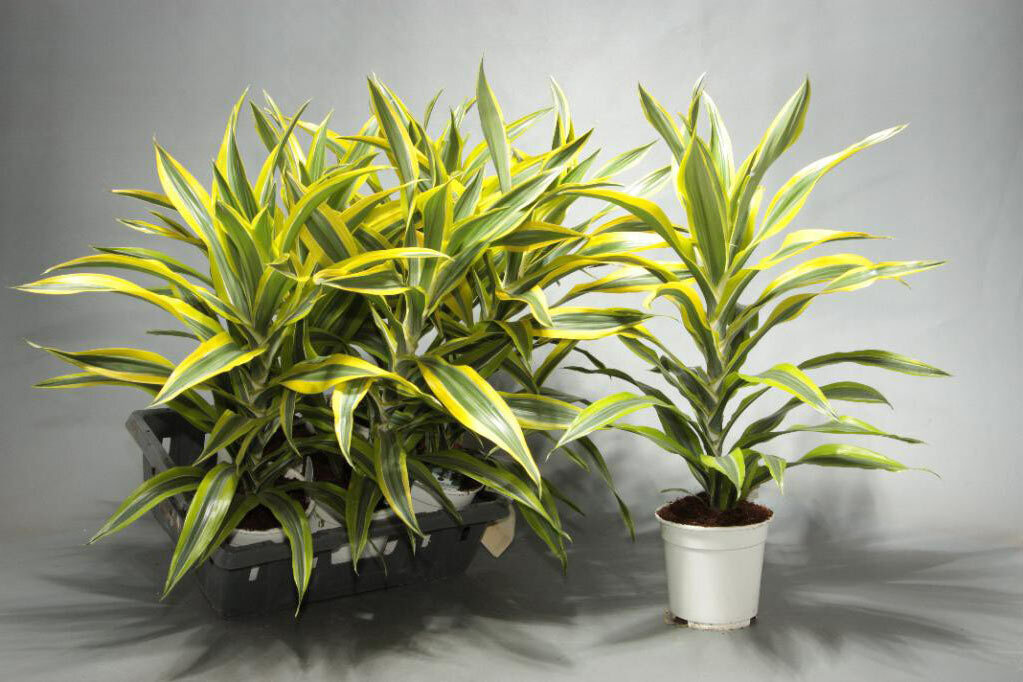
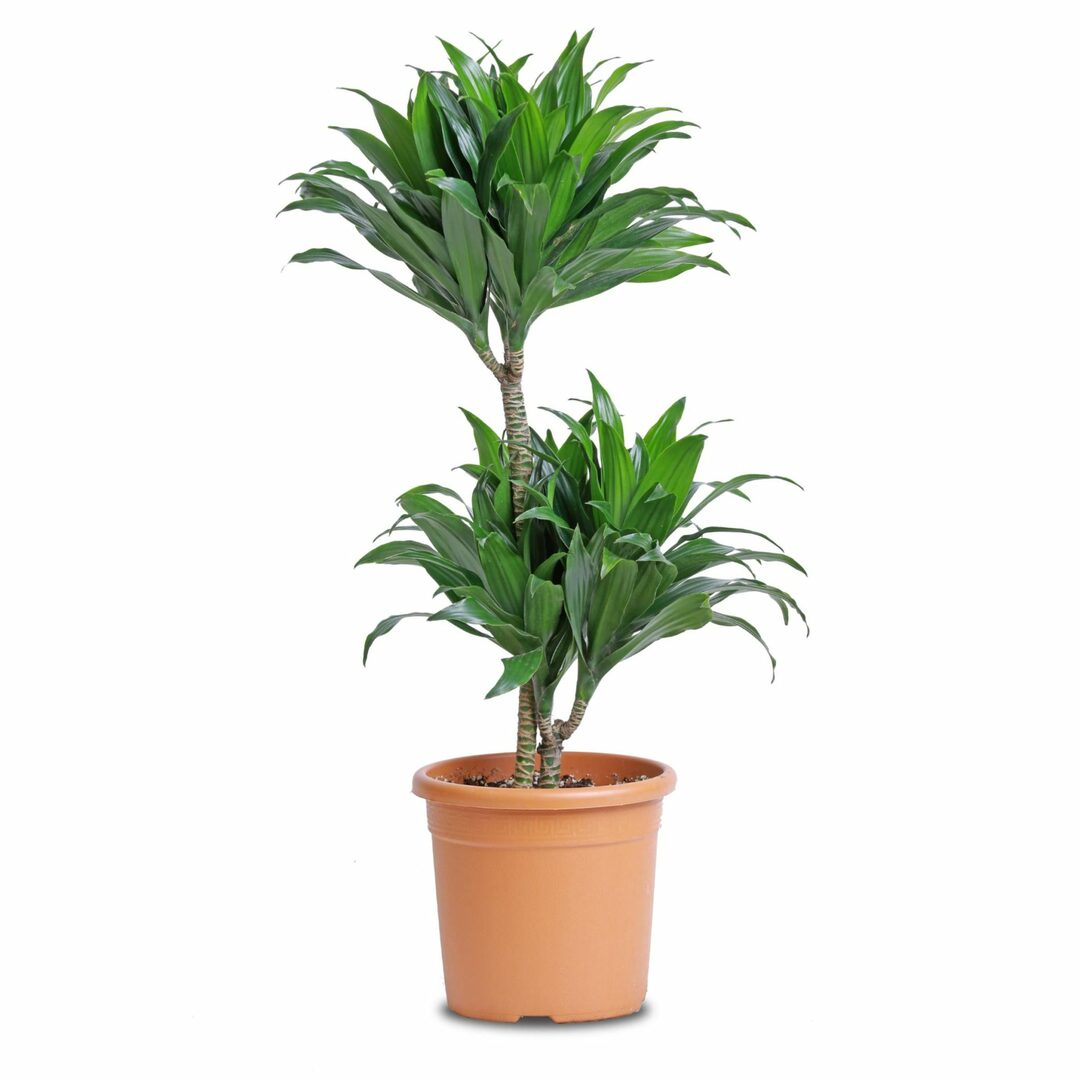
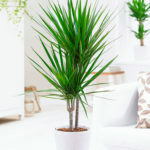
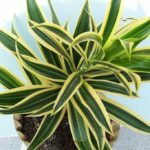
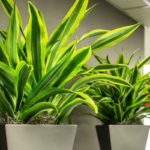
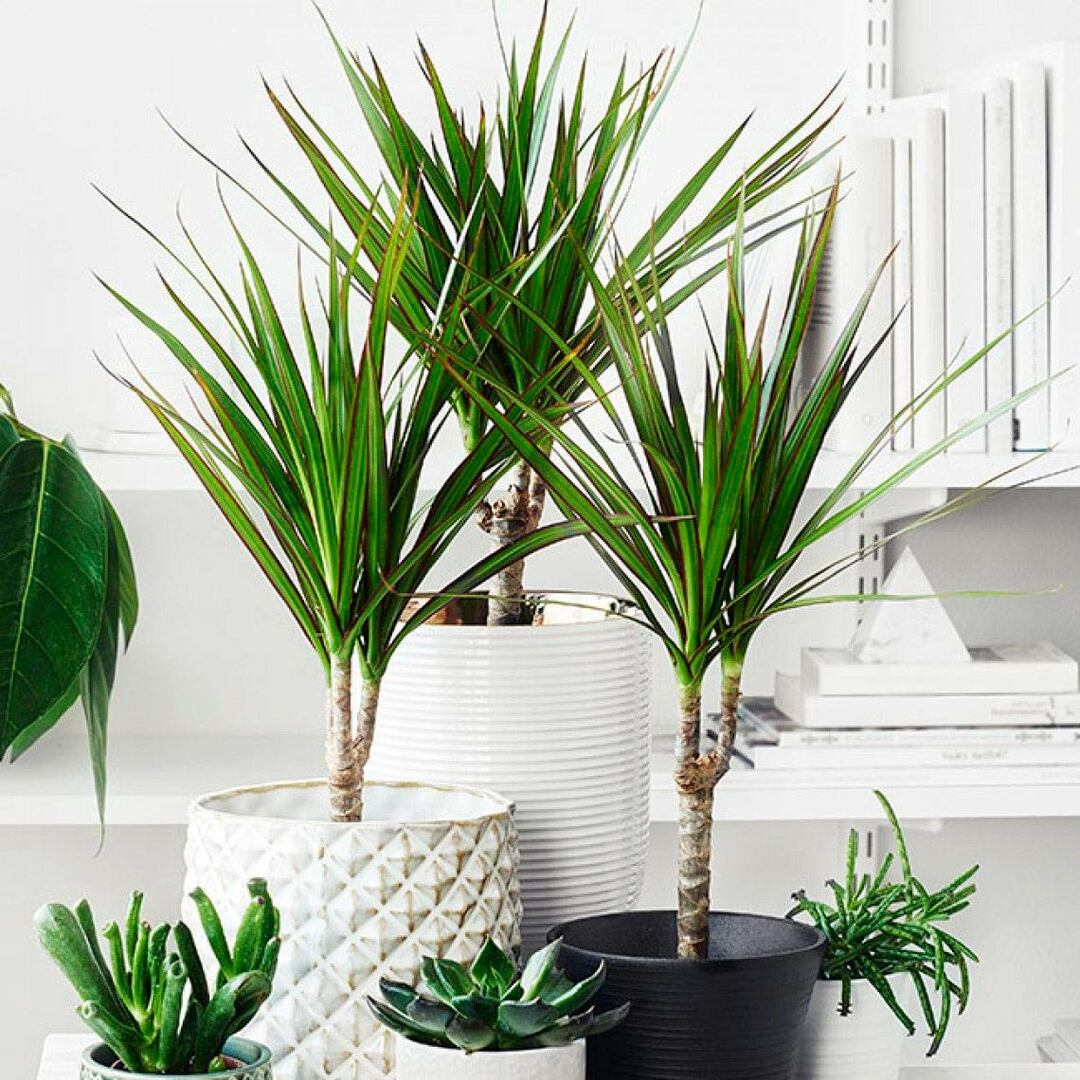
Since dracaena has the ability to purify the air of harmful compounds, it is better to use a stand with indoor flowers in the kitchen. Long leaves of the plant require constant care. To prevent dust from accumulating on them, and not to spoil the appearance of the green panel, they should be wiped daily.
Anthurium
Varieties with bright red inflorescences are suitable for growing on the stand. But it should be understood that such exoticism will delight households for a very short time, it will not be easy to grow a plant. Anthurium is suitable for a standard temperature regime, like most plants on a vertical gardening stand. In winter, it is better to move the panel with flowers to the window, and in summer to shade it.
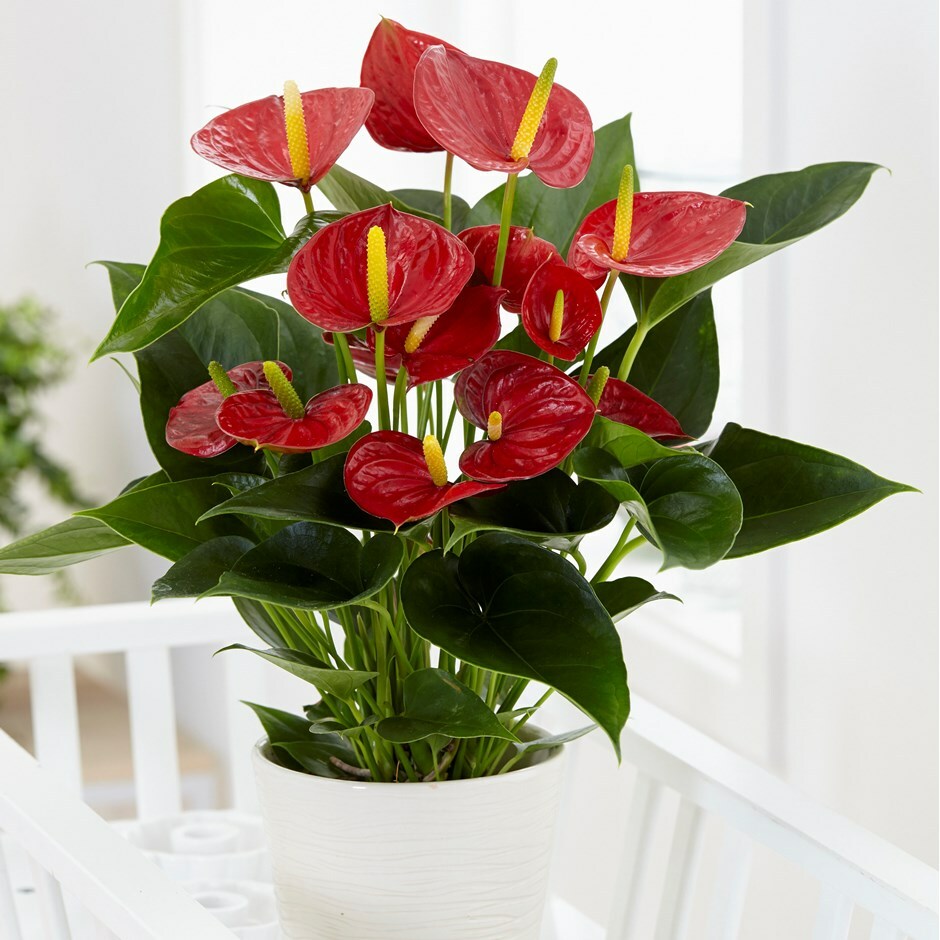
The flower of male happiness attracts good luck to the house and contributes to the creation of a strong family. Anthurium in the composition perfectly coexists with all plants, helps to fight depression.
Guzmania
The exotic flora has spectacular orange blossoms. It is great for upright posts in an apartment or garden. Tenacious roots hold tight to the soil, so the flower can be in any position.

Guzmania loves warmth, so it should be placed closer to the window opening, but not under the scorching sun. Top dressing is necessary during the flowering period. For this, liquid mixtures of organic and mineral substances are poured into the ground. Bright flowers can not only improve the indoor climate, but also activate energy.
Cissus
A beautiful vine from the grape family is ideal for a green stand as an ampelous plant. In favorable conditions, it pleases with rapid growth and the appearance of umbrella-shaped inflorescences. Quite a whimsical plant does not tolerate sudden changes in temperature, drafts. If watering rules are not followed and unfavorable conditions are created, all the foliage quickly flies around the cissus.
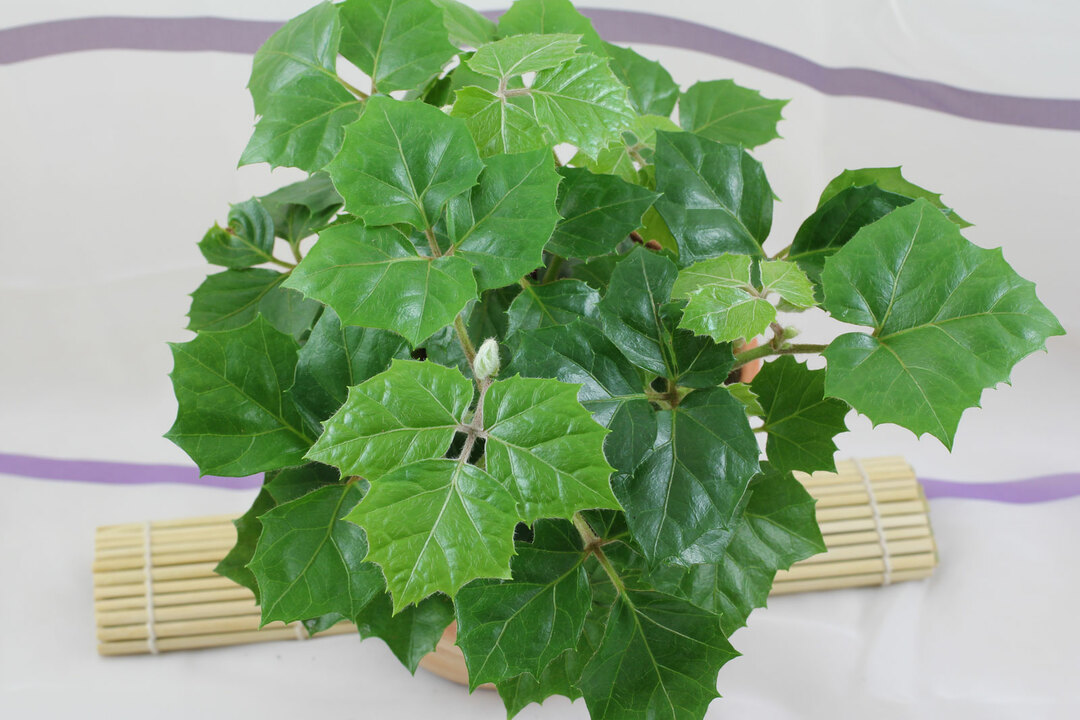
A plant with accelerated growth needs periodic pruning. It is better to remove excess shoots and carry out a clothespin in early spring. The most suitable species for home cultivation are Antarctic Cissus, striata, multi-colored, rhomboid.
Ivy varieties
Evergreen vines are distinguished by their endurance and unpretentiousness. Depending on the species, the leaves of the plant can be dark green or variegated. Some have protruding veins. It is necessary to use ivy in prefabricated flower arrangements carefully, since they have airy, rapidly growing roots. Highly sensitive tendrils at the ends of the shoots feel the support and move on to other plants.
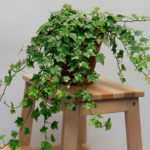
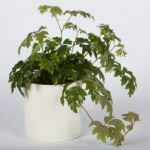
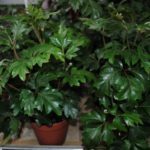
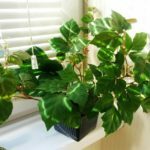
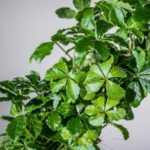
In order for ivy leaves to always have a juicy green color, the stand with the flower arrangement must be constantly exposed to diffused light. The soil can be any other than clay. Ivy must be pruned twice a year.
Philodendron
An absolutely unpretentious indoor flower can remain unattended for a long time and decorate a vertical panel. To do this, you can use any of its types, but varieties with curly stems will look better.
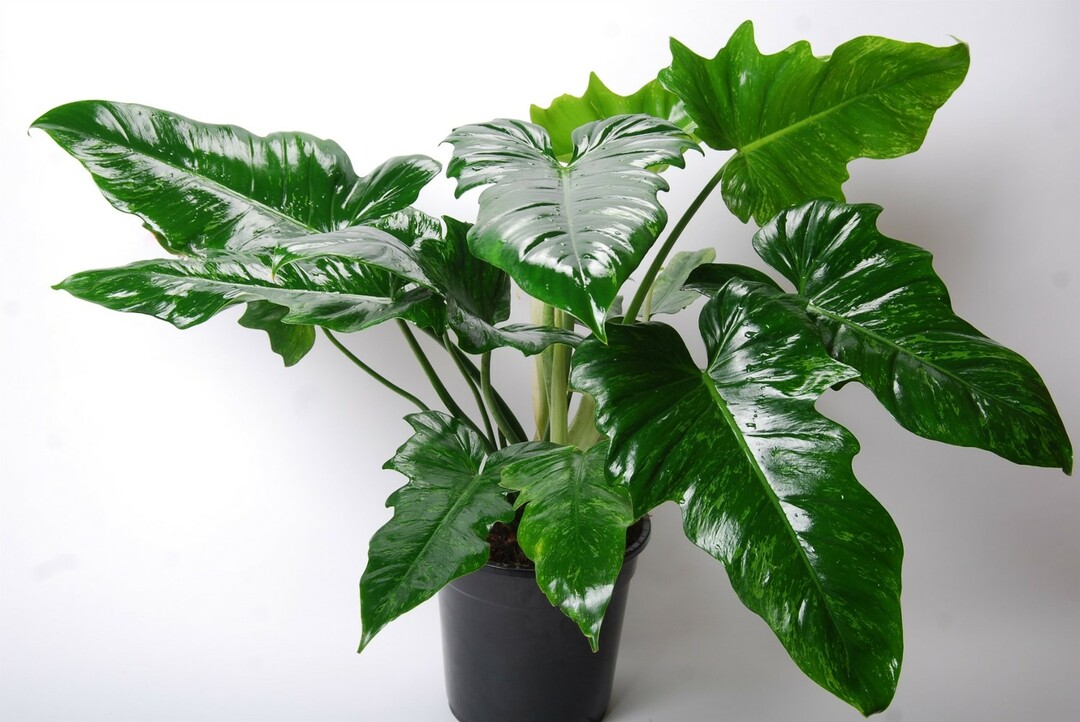
It is better to grow a philodendron in partial shade, away from direct sunlight. Drafts and air temperature rise up to 25 ° C should not be allowed. On dry summer days, foliage should be sprayed or wiped with cool water.
Growing plants with variegated leaf color, it should be understood that they require more sunlight than monochromatic ones.
Hypoestes
A bright herbaceous plant in the form of a bush has powerful succulent stems and foliage of interesting color. It is because of these qualities that it is often placed on a vertical bed in an apartment. Each leaf of hypoesthesia is covered with spots of pink, white, burgundy.
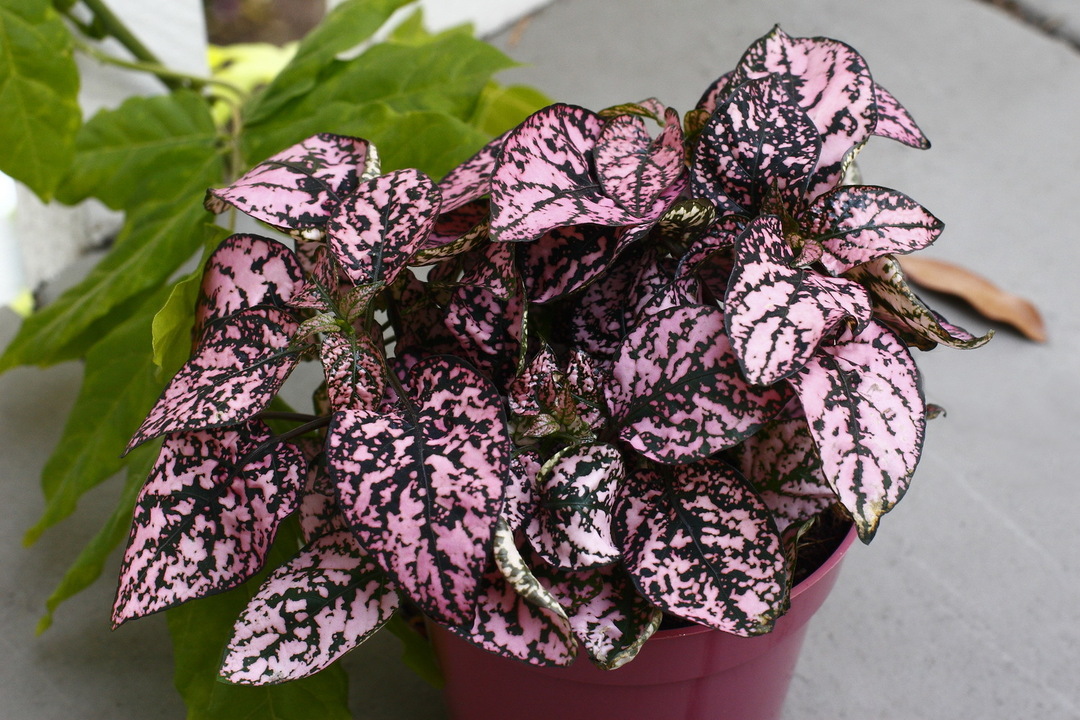

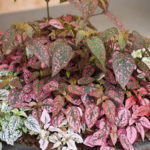
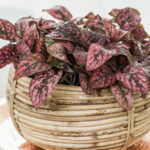

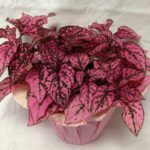
An unpretentious plant gets along well with all companions in the composition, but it also needs special care, a specific microclimate. The rapid growth of the flower will have to be kept under constant control.
Fern
Representatives of ferns are often used to decorate vertical stands. They are distinguished by lush greenery, bright green color and dissected leaves. When decorating stands, the following types are often used:
- Maidenhair. A fast-growing plant with many oval-shaped leaves. It is popular with florists due to its high decorative effect and accelerated growth;
- Nephrolepsis. The feathery leaves of a sprawling lush fern are collected in rosettes. Openwork foliage departs from the rhizome itself;
- Paronychia. Miniature plants grow rapidly and fill the entire space of the vertical flower bed. Such a background is great for bright flowering representatives;
- Antler. A plant with interesting leaves of a spore-bearing and sterile type will perfectly fit into a fern composition for landscaping.
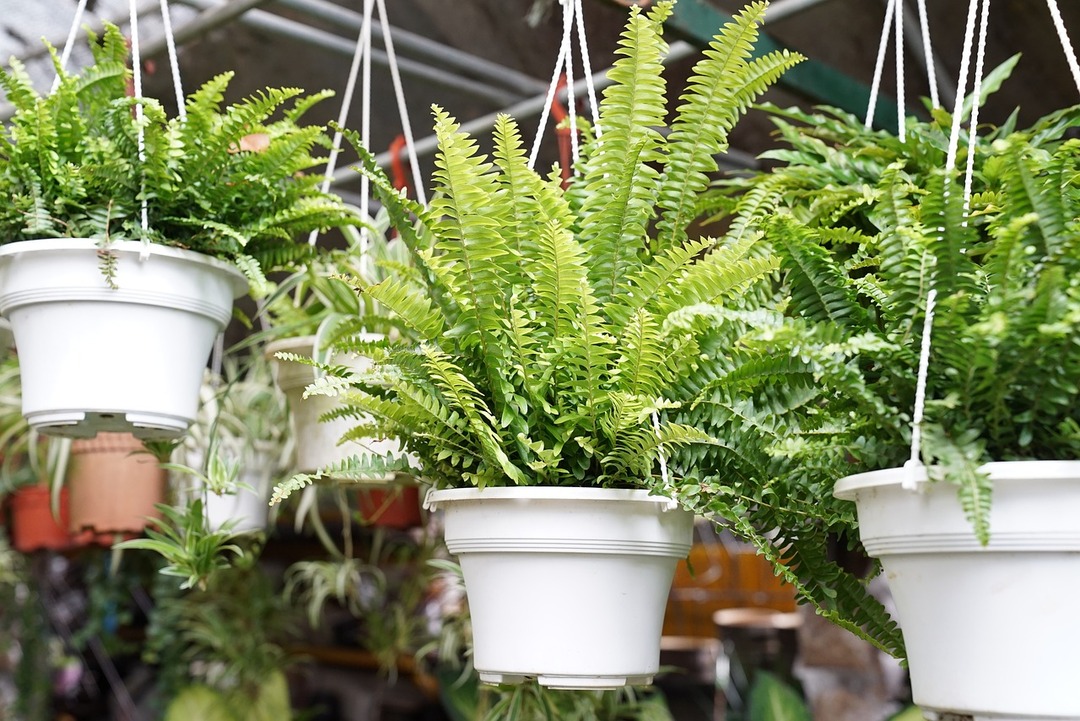
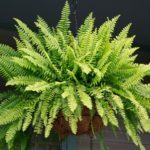
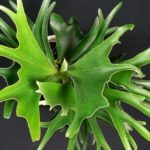

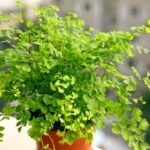
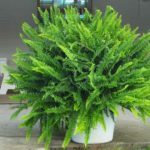
What to build from and how to create a vertical garden
The popularity of herbal gardens lies not only in a powerful impression, but also in the special properties of such a decor. Small structures will fit perfectly in small rooms and dilute compressed space. Massive shelving will be a good option for zoning a spacious room. Any vertical flower bed is easy to assemble with your own hands.
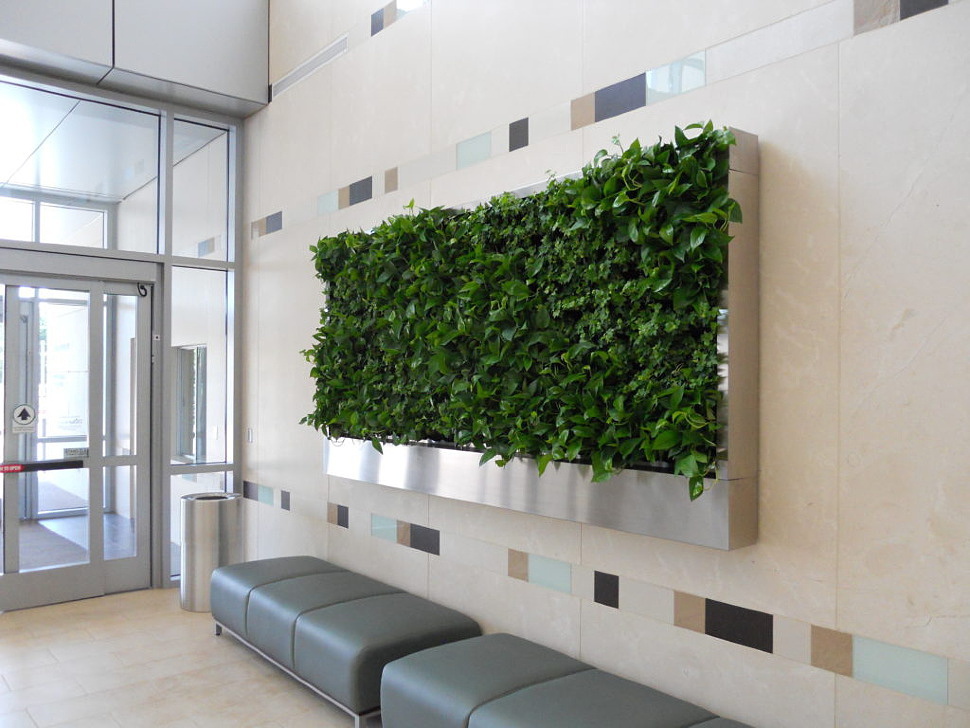
Three systems for creating a structure
The device and method of fastening suspended flower beds can be conditionally divided into several types. They choose the appropriate one depending on the type of plants, the size of the room, the design itself and the task that the green decor will perform in the future. Hanging garden systems can be as follows:
- Modular. A vertical plant rack is made of metal, plastic boxes, special fabric pockets. Each group of plants is planted in a separate module, then they are collected and fixed on the surface.
- Carpet. On a one-piece textile floor, many pockets are made of polymer film, filled with soil and plants. In order not to overload the structure, it is better to use small flowers and herbs.
- Container. Special containers (pots, boxes, pots) are attached to the wall, filled with soil and planted with plants, aromatic herbs and even vegetables.

From polymer textile fabric
Making a carpet garden according to P. Blancu is suitable for apartments and outdoor spaces. The required number of pockets must be formed on a large piece of polymeric felt cloth. This can be done in several ways using the bend method. The fold is glued with special glue, sewn on or fixed with a stapler.
Then the canvas is attached to the waterproof surface and transferred to the wall. It can be any metal stand, plastic panel, thick film. All pockets are filled with soil mixed with fertilizer and the plants are planted. Watering can be done manually or using drip irrigation systems.

Metal mesh with handkerchiefs
It is easy to make such a bed from the remnants of a chain-link mesh and small containers. The base can be placed along a wall, fence or rolled up. The section diameter is chosen taking into account the type of plants and their characteristics. The mesh background can be masked with straw or left as it is. Then the containers are tied to the cells with wire and filled with soil. The boxes can be of the same size and diameter, or have very different shapes.
The method of placing containers on a grid is the most practical and versatile. The flowerpots can be attached to any base. The material of their manufacture is not important. For step-by-step connection, clamps, wire, fishing line, strong rope, adhesives are used.
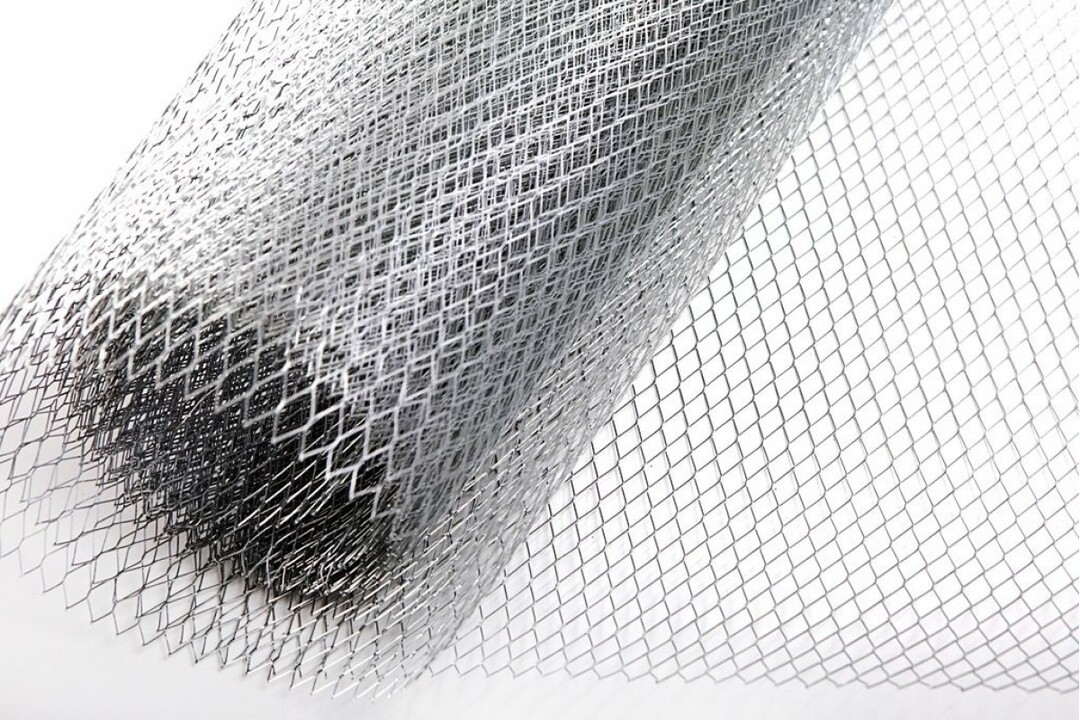
Made of wood
Wooden supports for a vertical garden can be placed anywhere on the site. Long beds are formed from the slats, fill the voids with earth and place any plants that can take root in such conditions. A massive timber structure can be used as an additional wall, install them near the gazebo, recreation area. When choosing this type of landscaping, you must take into account the number of plants. The more of them, the more time it will take to care, watering, feeding.
For climbing plants, you can make a wooden lattice on supports according to special instructions. This option is especially suitable for specimens creeping upwards. When the greenery grows enough, this decor will create excellent shading, hide what is happening in the area from prying eyes.
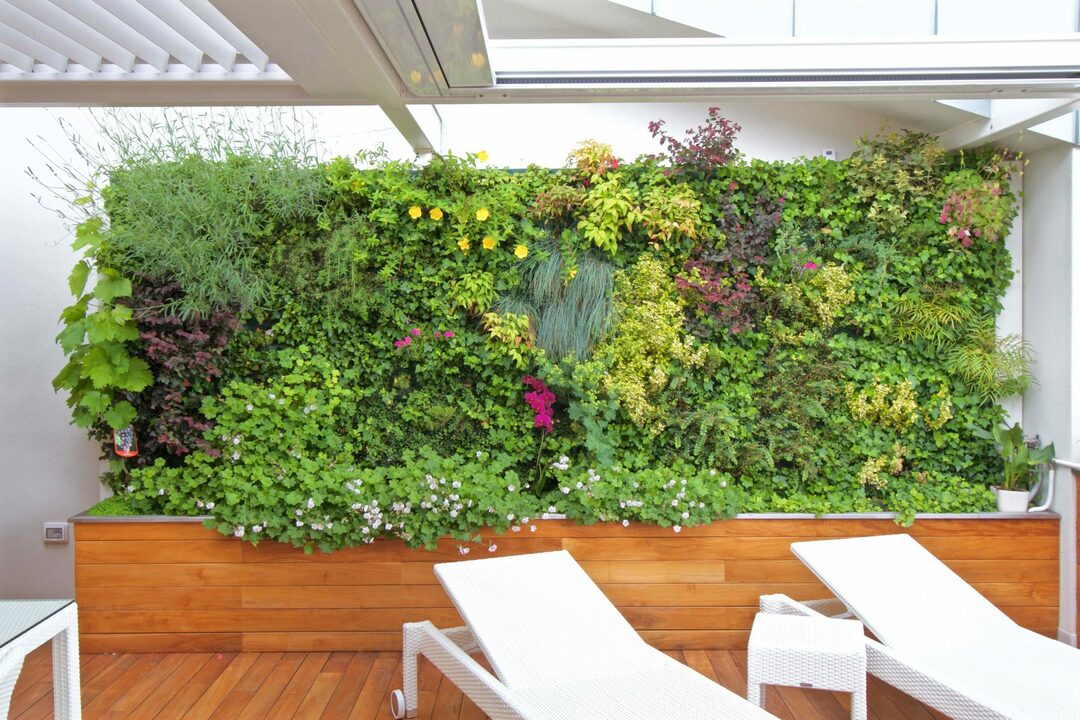
From pallets
Ordinary pallets are suitable for creating original garden decor. It is necessary to remove every second crossbar from the structure and nail it on the other side. As a result, you get a flat two-sided staircase. Between the boards, you need to make textile layers, fill them with soil and dig in the plants.
The original idea of creating a vertical flower bed from pallets is a chaotic installation of identical pots on the surface. Plastic pots are screwed to wood with self-tapping screws or fastened to metal staples.
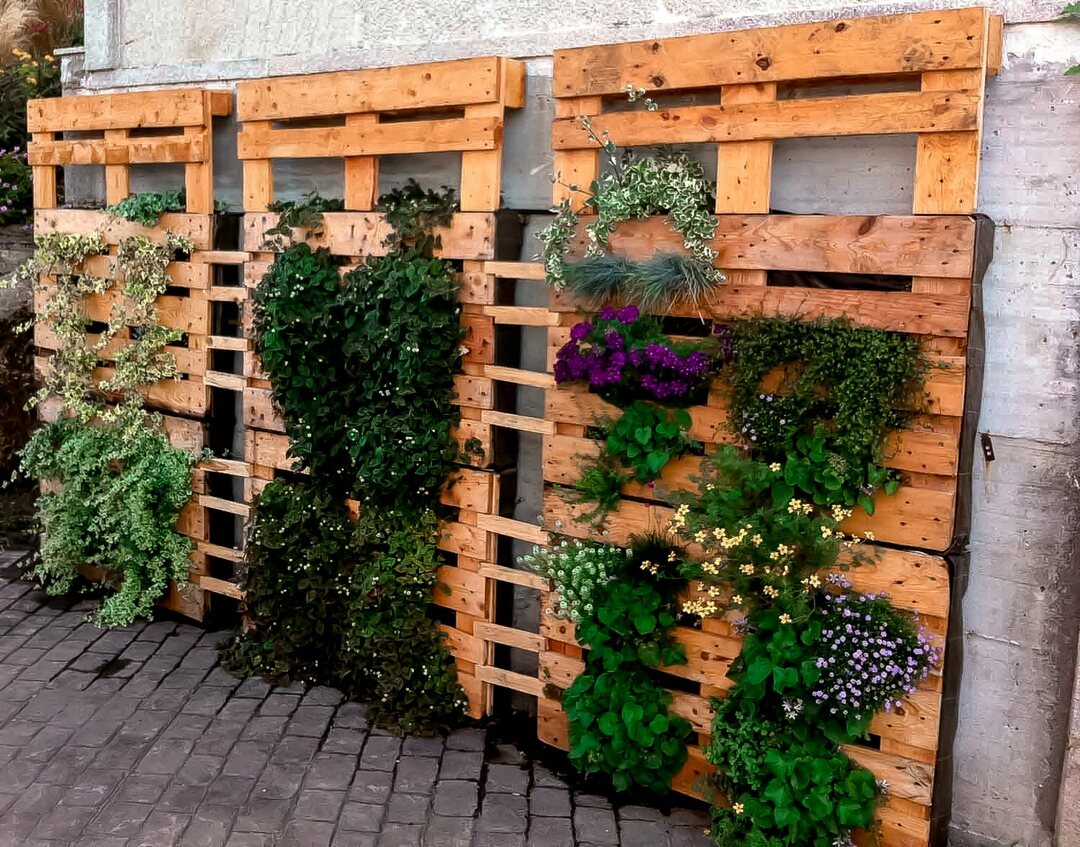
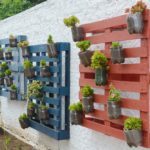
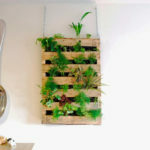
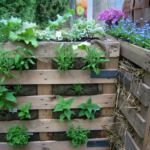
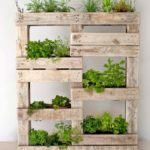
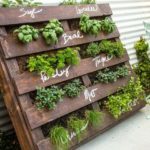
The pallet will also make a great stand for miniature plants. The burlap must be attached to the inside of the product with a stapler. Sheathe the perimeter vertically with a thick foil. Fill the pallet with earth through the side hole. We make small holes in the burlap, place the plant.
From plastic bottles
To create a simple and original design, you will need a considerable number of plastic bottles. They can be positioned horizontally or vertically. The first option involves cutting through the side part; in the second case, only the lower part of the container is needed.
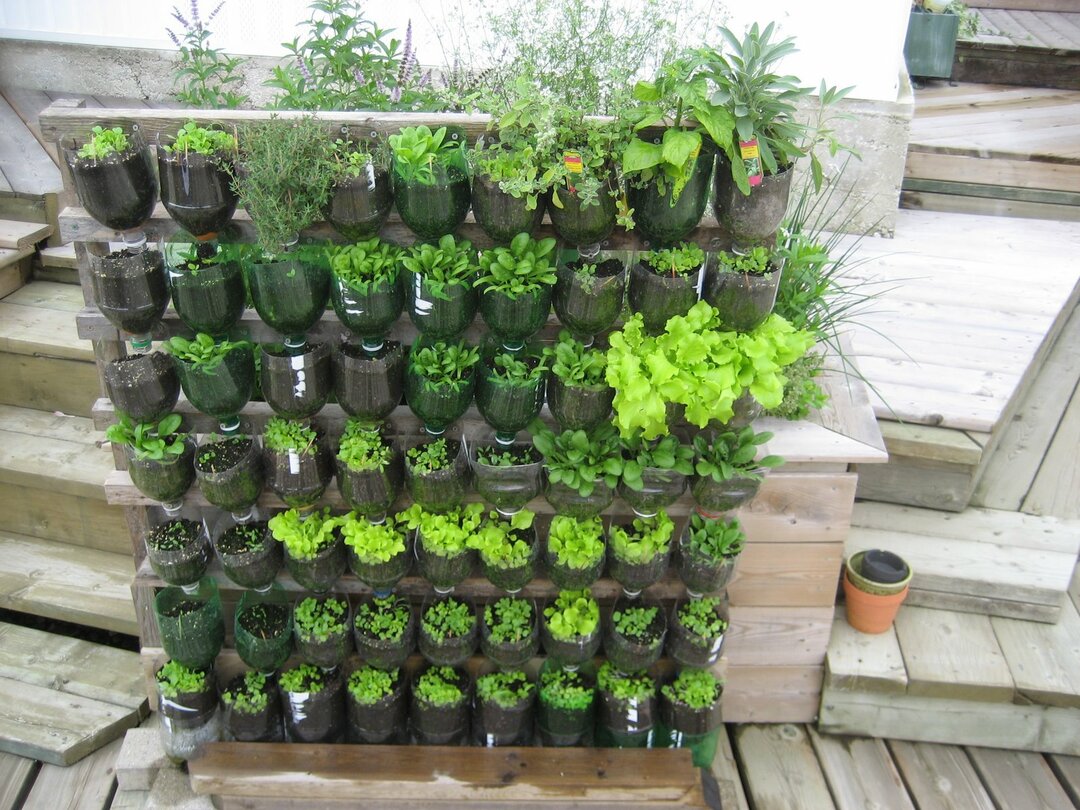
Plastic bottles will make an excellent imitation of a hanging tropical garden. Any representatives of the bromeliad family, unpretentious fat women, succulents will take root here. A kindergarten made of affordable plastic does not require a lot of space and financial investments. You can create it with the whole family, involving children in the entertaining work.
From the pipes
Any summer resident can create an impromptu flower garden from plastic pipes. When choosing plants, the diameter of PVC products should be taken into account. The elements are collected in a rack and holes are cut for pots with seedlings. Also, light pipes can be fastened with rope and hung on a fence or wall. If tall plants are planted, such a structure will become an original fence. For the convenience of irrigation, a drip irrigation system is located inside the pipe.
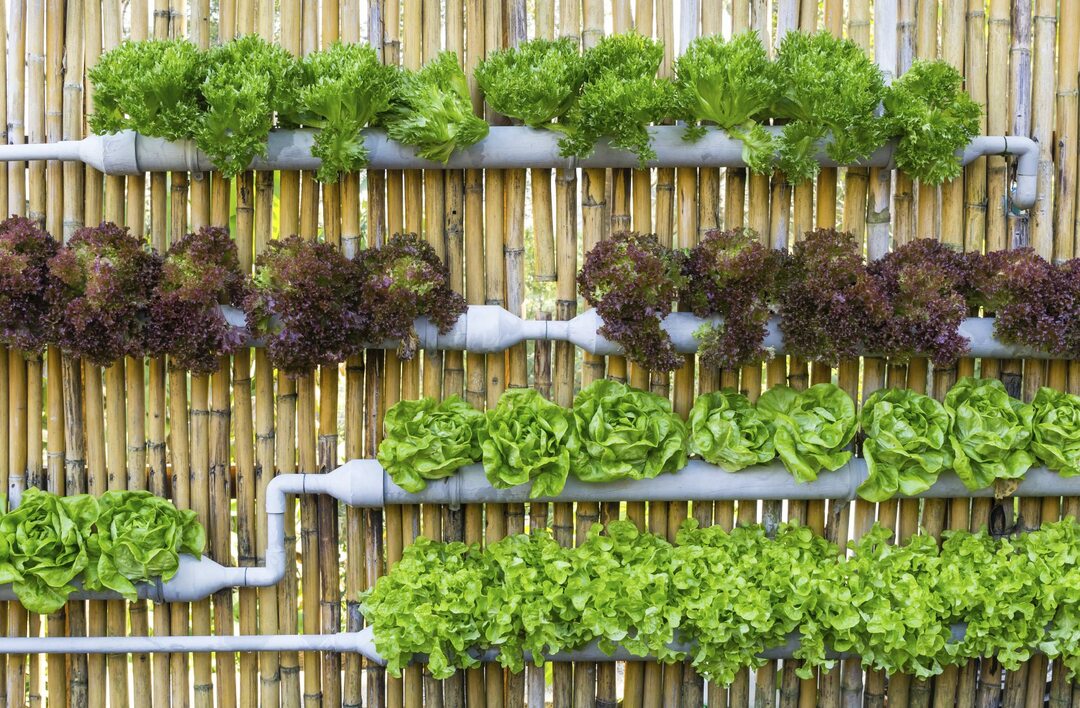
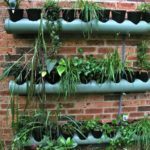
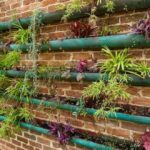
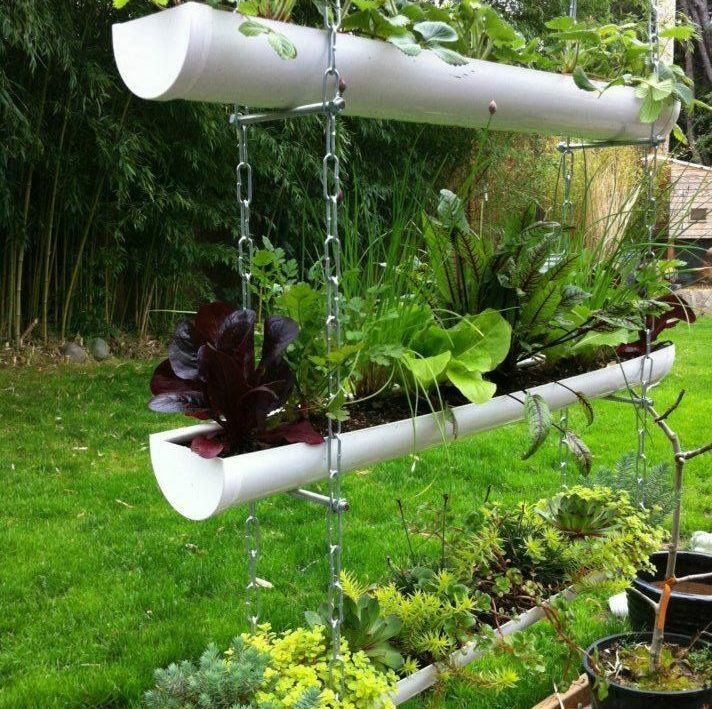
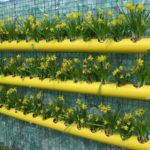
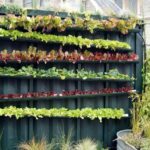
How to maintain a wall garden
In most cases, the phytowall is equipped with automatic watering, which nourishes the plants, ensures the preservation of the fresh appearance of the entire structure. But even in this case, you will have to periodically monitor the watering, check the system for problems. It is necessary to test the soil for moisture at least once a week, to monitor the content of the nutrient medium in the container.
In an automatic irrigation system, the pump can break, the filter and droppers can clog. An element that has become unusable needs to be repaired, cleaned, or replaced. The tubes that carry food to the plantings should be changed at least once every two years. It is also necessary to monitor the presence of nutrient fluid in the tank, to replenish the stock of solution in a timely manner.

In order for a living wall to last a long time, it is worth paying attention to the plants themselves. Diseased species are replaced by new ones. In rooms with dry air, it is recommended to additionally spray the crops with water. It is required to constantly keep the eco-wall clean, remove dry, fallen leaves and stems, remove faded flowers. It is worth doing the prevention of stretching, the appearance of a spider mite.
Conclusion
A vertical garden in an apartment or office is not only a unique decorative element, but also serves for practical purposes. It purifies, humidifies the air, saturates it with oxygen, and promotes well-being. You can build a structure yourself, but it is better to contact specialized firms, where experienced employees help you decide on the design, advise plants that match a specific design, complete the installation systems.



